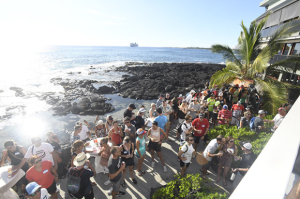I thought this pandemic would murder bike shops. And it has murdered some. Especially high-end shops, and definitely bike fitters. But a lot of shops are doing okay, limited to certain product categories. Sure, you might say, stationary trainer sales are through the roof. But that’s not all, and it’s not just mail order who’s doing well. It’s also select brick & mortal. Take Landry’s Bicycles, a 7-store chain in greater-Boston.
“Last week sold 610 bikes and we built 350 - we can’t build them fast enough,” said Mark Vautour, manager at Landry's, and Mark's seen a lot in his 23 years at that establishment. Landry’s is big in metrics, and in transparency of its metrics. This is why Landry’s is always a helpful bellweather. “We’re up in units, but down in dollars. Every kids bike we have is selling. In every category of bike, the lowest price is selling: hybrid, gravel, full suspension, everything.”

This is what I’m hearing, across the U.S. Bikes at $500 and under, they’re selling like toilet paper. In fact, the scarcity of these bikes has forced the price points higher. I asked Mark what the fulcrum is, where he’s down above a certain price point and up below. It appears to be somewhere between $1,200 and $1,500.
His stores, year over year are, depending on the store, down 11 percent to up 2 percent. Those that are down rely heavily on University traffic, and with colleges and universities closed (Harvard, MIT, Boston College, upwards of 2 dozen colleges throughout the metro area) those particular stores are hard hit.
But it’s not that. Primarily. It’s that his stores are, technically, closed. “No customers in the door. We have 2 garage doors in back, a quarantine zone,” Mark said. This is where bikes come in and go out for service, and where new bikes go out. There’s no parts & accessories sales, no apparel. “No racks, locks, lights, fenders. Nobody browses.” Landry’s is selling 2 models of helmets now, rather than its usual 12. It sells a $65 model and one for $80. Both black. But Landry's service departments are now working 2 shifts, and this is in Boston, the 3rd hardest hit city by this pandemic.
Over my adult life I’ve seen the Alexi Grewal surge in cycling, the Greg Lemond surge, the Lance Armstrong surge, and now the Covid-19 surge. It’s not just folks hopping onto 2 wheels who’re incremental to the activity, it’s metro areas carving out space for pedestrians and cyclists. Brookline, Mass, adjacent to the store where Mark Vautour works, took 2 lanes of traffic from Beacon Street – a major boulevard – and coned off 1 lane for bikes.

The New York Times wrote a month about the cities pulling vehicles from streets: Oakland, Berkeley, Boston, Minneapolis. Two weeks ago there was news about San Diego doing the same.
Select bike makers are not only not down, many are dead-even year-over-year, and some are up. Trek Bicycles is privately held, and rarely gives out financial data, but it reported to me that it is not down so far this season. Trek laid out a blueprint for how its partner retailers should transact during the pandemic and stores like Landry’s have benefited. It’s click-and-collect business (buy the bike on the website and retrieve it at the LBS) is off the charts. According to one estimate, it’s up by a couple of orders of magnitude over last year.
Of 30 brick & mortar bike shops I queried, 20 are and have remained open in some fashion during lockdown. Of those who’re open, they all report success in the under $800 complete bike segment, and they all say service is either way or somewhat up. The great majority say their stationary trainer business is up, and about half say their helmet business is strong. But that’s it. Few report that other segments are strong.
These stores are undeniably aware of this big surge in cycling. But many are sanguine about the long-term effect. “Momentary blip” and “short term uptick” said several. Another told me, though, “I would bet that it will be a gateway for a large number of new riders that will likely take up the sport and continue to grow after the pandemic.” Some are adapting to the new customer. “We now stock bells, phone cases and kickstands alongside wetsuits and Zipp wheels!”
Another area where Landry’s is historically very strong is its attachment to bike advocacy. It occurred to me that now, more than ever, there is a window open for advocacy groups, to keep some of these roads as bike thoroughfares. “I do think our advocacy groups are going to lean on representatives,” said one shop owner. “Now’s a good chance to see what the streets look like without cars on them. Streets without cars are good for everybody.”
[PHOTOS: Courtesy Landry's Bicycles]



